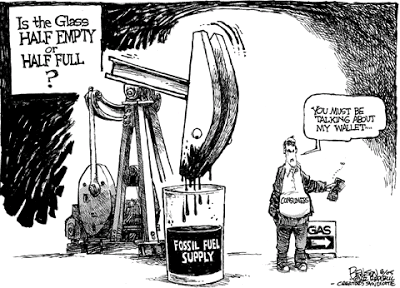
Have We Really Hit Peak Oil?
And if we have, we had better prepare to change the way we live.
By Richard Heinberg / May 20, 2008
Last week, Senate Democrats introduced legislation that would halt a U.S. arms sale to Saudi Arabia worth $1.4 billion. The implication is clear: no more war toys for the Saudis unless they agree to up their oil output.
The same day, the House approved a Senate plan to suspend oil deliveries to the Strategic Petroleum Reserve in hopes of diverting that oil to the market, thus lowering the pump price a tiny amount. A week earlier, a handful of Senators proposed a bill threatening a trade dispute with members of OPEC if the organization doesn’t stop “its anti-competitive practices and illegal export quotas on oil.”
It’s understandable that our elected leaders would want to do something about the meteoric rise of gasoline, diesel, and heating oil prices that are now bankrupting independent truckers and forcing many folks in colder states to choose between being able to stay warm and being able to drive to work. Yet efforts like the ones just mentioned are based on a profound misperception of why oil prices are rising. The real problem is summed up in the phrase “Peak Oil.”
Petroleum is a finite substance and we have reached the inevitable point at which it simply isn’t possible to increase the rate at which we extract it from the ground. Most oil producing countries, including the US, have already seen their glory days and are now watching output from their wells gradually dwindle. Only a few nations are early in the production cycle and able to ramp up the rate of flow. Here is a concise definition of Peak Oil from my colleague Chris Skrebowsi, the editor of Petroleum Review in London. He says: “Global oil production falls when loss of output from countries in decline exceeds gains in output from those that are expanding.”
Well, how are we doing? Who’s winning, the decliners or expanders?
According to last year’s scorecard, the decliners won. The same happened in 2006. And that’s with oil prices at record highs, presumably offering every incentive for nations that can produce more oil to do so. Does this mean we are at the all-time peak of global oil flow rates now? Not necessarily. There are large new production projects coming on line this year and next, including one in Saudi Arabia that will add several hundred thousand barrels a day to that nation’s productive capacity.
However, on the other side of the balance there is some very bad news. Russia, the world’s leading oil producing nation and the country that has been responsible for the lion’s share of the world’s production growth over the past decade, has gone into decline. Optimistic analysts hope Russia will be able to keep production more or less flat for a few years, but that may not be possible. The past few months have seen reductions in output. Other important exporting nations like Nigeria and Mexico are also in trouble.
The timing of the global peak may still be unclear. But surely we can’t afford, as a matter of national policy, to assume that it will be decades in the future — given that all of the symptoms are staring us in the face now. Some economists say that current high oil prices are largely due to the falling value of the dollar, or to speculation. Simple arithmetic tells us that dollar depreciation has added only ten or fifteen percent to oil’s cost over the past two to three years.
Read the rest here. / AlterNet
Thanks to David Hamilton / The Rag Blog

















